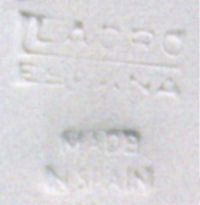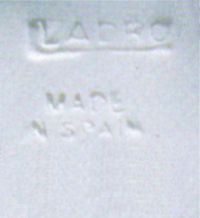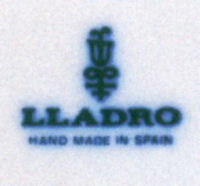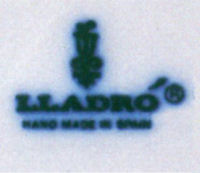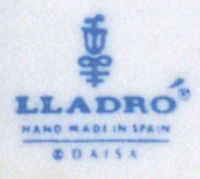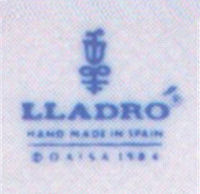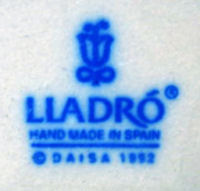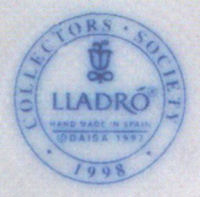
~Buy Lladro figurines and collectibles ~Lladro Marks, Logos, Backstamps Lladró was born in the mid-1950s as a small family workshop in Almácera, a tiny farming community near the city of Valencia, on Spain's eastern Mediterranean coast. Born into a humble farming family, the brothers Juan, José and Vicente decided to dedicate their free time to making ceramics as a means of improving their prospects for the future. They enrolled in the Valencia School of Arts and Crafts, where Juan and José studied drawing and painting, while the youngest brother, Vicente, took up sculpture. In order to put their new knowledge into practice, they built a Moorish-style kiln in the patio of their parents' home. As their experiments became increasingly successful, they began manufacturing and selling their first ceramic flowers on the local market. Meanwhile, they had started to design and produce their own figurines in porcelain. In 1958 they moved from their small workshop in the family home in Almácera to a factory located in the nearby town of Tavernes Blanques. The 1960s were years of strong growth and development. In fact, the studios in Tavernes were enlarged seven times until in 1969 the foundations were laid for what was to become Porcelain City, the home of Lladró porcelain art today. For over two decades since that time, Lladró has continued to spread throughout the world, fueling growth back home in tiny Tavernes. Today, with a headcount of two thousand people, Lladró markets its creations in over one hundred countries around the world. Perhaps China's greatest gift to the world was the way it combined simple clay with "secret ingredients" to create a material which was both beautiful and practical: porcelain. It is believed that porcelain first appeared during the Tang dynasty (618-906). Marco Polo's seventeen-year stay in China in the late 11th century had a great impact on European culture. As an example, purchasing porcelain "objets d'art" became an obsession with European aristocrats. Porcelain was viewed by European royalty as a highly desirable luxury product, a fitting way to pay themselves homage. This increase in demand occurred precisely at a time when the manufacture of imperial porcelain in China was becoming problematic. Product costs were soaring, pilferage was rampant, and materials were in short supply. The porcelain market looked insatiable. Foreign tradesmen had great difficulties overcoming Chinese reluctance to maintain supplies, bent as the Chinese were on preserving the secret of porcelain manufacturing. Meanwhile, in Vienna, Venice and other European cities, attempts were being made to create what was to become European porcelain. In the 1940s, the Lladró brothers revisited the history of porcelain manufacturing, creating their own formula for porcelain paste and refining their manufacturing techniques on all fronts: pigments, molds, varnishes, and firing times, resulting in pieces that not only incorporate great beauty, but emphasize quality of the highest kind. Lladró figurines are given an additional title in English as well as the Spanish original, however these names are frequently not translations (figurative or literal) but new names that are more likely to appeal to an English speaking audience. A further area for confusion is that the names of the pieces can change throughout their run so the same figurine can often end up with several titles.
Lladro Marks, logos, backstamps With a view of their works in the context of classical artwork, Lladro pieces have a distinct form and color. In 1971, a logo was created that represented the link both art and science, the basis of all Lladró creations in fine porcelain. The logo joined an ancient chemical symbol with a stylized version of a very popular flower from the local Valencian region known as the “bellflower”. This flower is incorporated as both a tribute to nature, the mother of clay, and to the region of Spain where Lladró was born. The finishing touch to this corporate logo is the Lladró name printed below the art/science symbol. A Lladro figurine can be dated as well as authenticated by the marking or trademark logo on the underside of its base. A figurine lacking one of the following marks is quite likely to be a fake. The exception to this rule would be the earliest figurines which were not marked - however these are quite rare. The first Lladro trademark was impressed into the porcelain. This mark was used from approximately 1960 to 1963.
The second Lladro logo was also impressed into the porcelain. This trademark was used from approximately 1965 to 1970.
The third Lladro mark was changed to a blue backstamp which featured the now famous Lladro bellflower. This trademark was used from about 1971 to 1974. The missing accent over the letter "o" was intentional.
The fourth Lladro marking or backstamp was used from approximately 1974 to 1977. The accent was added as well as a trademark sign.
The fifth Lladro stamp was used from around 1977 to 1984. It added the copyright acronym DAISA which stands for Disenos Artisticos E Industriales, S.A.
The sixth Lladro backstamped logo added a copyright date and was used from about 1984 to 1989.
The seventh Lladro marking was introduced in 1990 and is still currently in use. It featured a revised bell flower logo and typeface.
Another Lladro backstamp that you'll see from time to time is the Lladro Collectors Society mark. These are used on "Members Only" figurines.
A final note. Scratched logo on the figurines is considered to be "second factory". But now the Lladro company in USA insure that the scratched logo can also mean that the figurines were discounted and can be in perfect condition, not "second factory". Now if you're buying a figurine for decorative reasons, figurines with a scratched logo can be a wonderful way to acquire the figurine for lower price! When buying a Lladro figurine as an investment the authentication process is quite important. You certainly want to ensure that you're not spending your money on a fake. source: http://www.theprudentcollector.com/lladro_marks.html |
| Categories |
|
Shop by Gift Idea |
|
Store Pages |

